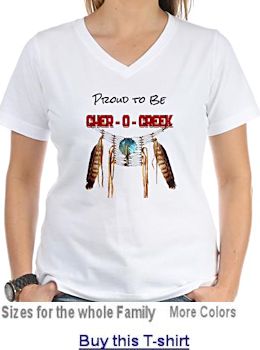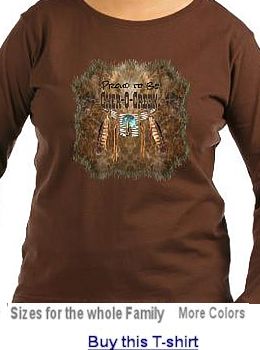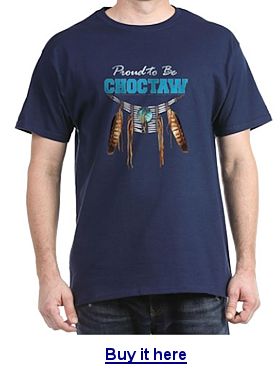State Tribes C-D
An alphabetical list of state recognized tribes of the United States C to D. Links to tribal profile pages are at the bottom of the page.
State Recognized indian tribes that start with C
Caddo – See Adai Caddo Indian Nation (LA)
Cherokee Tribe of Northeast Alabama
Cherokees of SE Alabama – See Cher-O-Creek Intra Tribal Indians (AL)
Cher-O-Creek Intra Tribal Indians
Cheroenhaka (Nottoway) (VA)
Chickahominy Tribe (VA)
Chinook Indian Tribe (WA)
Choctaw Apache Tribe of Ebarb (LA)
Clifton Choctaw (LA)
Chickahominy Tribe RFD 1, P.O. Box 299 Providence Forge, VA 23140
State Recognized indian tribes that start with D
Article Index:
The Cher-O-Creek, Intra Tribal Indians bloodlines are composed of more than one Native Blood of the Five Civilized Tribes indigenous to the State of Alabama, primarily Creek and Cherokee. Many of Cher-O-Creek members have both Creek and Cherokee bloodlines.
Official Tribal Name:Cher-O-Creek Intra Tribal Indians
 Address: P.O. Box 36302, Dothan, AL 36302-0717
Address: P.O. Box 36302, Dothan, AL 36302-0717
Phone: (334) 712-1795
Fax:
Email:
Official Website:
Recognition Status: State Recognized
Traditional Name / Traditional Meaning:
Common Name / Meaning of Common Name:
Alternate names / Alternate spellings / Mispellings:
Formerly the Cherokees of SE Alabama
Name in other languages:
Region:Southeast
State(s) Today: Alabama
Traditional Territory:
In the 1820’s and 1830’s, the United States pressured the Southeast Indian nations to cede their homelands and move westward. The tribes that didn’t go voluntarily were forced to go by the Indian Removal Act. But, there were fragments and remnants of the Five Civilized Tribes who avoided the Removal by escaping into the woodlands and mountains, marriage to white settlers and trappers/hunters. And, some escaped by living among the Freedmen people as “Black Dutch” or “Black Irish”. All the while, they were denying their American Indian bloodlines. Many stopped speaking their native language to avoid their young ones being heard speaking their native language. All the children were cautioned to avoid answering questions when asked about their families.
Confederacy: Five Civilized Tribes
Treaties:
Reservations:
Land Area:
Tribal Headquarters:
Time Zone:
First European Contact:
Population at Contact:
Registered Population Today:
Tribal Enrollment Requirements:
Genealogy Resources:
Black Creeks adopted through the Dawes Commission between 1898 and 1916
Government:
Charter:
Name of Governing Body:
Number of Council members:
Dates of Constitutional amendments:
Number of Executive Officers:
Elections:
Language Classification:
Language Dialects:
Number of fluent Speakers:
Dictionary:
Origins:
Bands, Gens, and Clans
Related Tribes: Cherokee and Creek
- Alabama-Coushatta Tribe (Texas) (F)
- Alabama-Quassarte Tribal Town (Oklahoma) (F)
- Alibamu Indians
- Chattahoochee Creeks
- Cher-O-Creek Intra Tribal Indians (S)
- Coushatta Tribe of Louisiana (Louisiana)
- Creek Freedmen
- Kialegee Tribal Town (Oklahoma) (F)
- Lower Muskogee Creek Tribe (East of the Mississippi) (S)
- Machis Lower Creek Indian Tribe (Alabama) (S)
- Mississippian Moundbuilders
- Muscogee (Creek) Nation (Oklahoma) (F)
- Ochese Creeks
- Poarch Band of Creek Indians of Alabama (F)
- Star Clan of Muscogee Creeks (Alabama) (S)
- Thlopthlocco Tribal Town (F)
- Also see Creek Tribes
Traditional Allies:
Traditional Enemies:
Societies:
Ceremonies / Dances:
Modern Day Events & Tourism:
Legends / Oral Stories:
Art & Crafts:
Animals:
Clothing, Adornment, and Housing:
 Prior to the Removal, the Creek and Cherokee families enjoyed a lifestyle of living in nice homes, dressing in fine clothes and wearing elegant jewelry. Their children were educated by tutors and the missionaries. Children were taught to respect their elders, good behavior, and to care for Mother Earth and the animals by their Elders and “extended” families. The tribe took care of their widows, elderly, orphan children and the disabled.
Prior to the Removal, the Creek and Cherokee families enjoyed a lifestyle of living in nice homes, dressing in fine clothes and wearing elegant jewelry. Their children were educated by tutors and the missionaries. Children were taught to respect their elders, good behavior, and to care for Mother Earth and the animals by their Elders and “extended” families. The tribe took care of their widows, elderly, orphan children and the disabled.
Subsistance:
The Creek and Cherokee were excellent farmers and hunters. They planted their crops in the fertile bottom land along the rivers, creeks, streams and lakes. Their crops flourished and became their financial resources. They were farmers first and hunters second.
Economy Today:
Religion & Spiritual Beliefs:
As time passed, the general society became more acceptable and tolerant of the Indians living in their communities. The missionaries and Catholic people encouraged them to affiliate with their churches.
The society’s acceptance and tolerance was the beginning for the Indians to feel less afraid of the “white” man. By word of mouth, the local Indians began to meet together to “share” what they could remember of their heritage. From group meetings, Gatherings began. Usually, Elders were the ones who could recall the stories, dances, drum, the Cultural and Traditional Ways. Slowly, as the years have passed, Cher-O-Creek citizen’s Indian Pride has returned.
Burial Customs:
Burial customs practiced by Creek Freedmen
Wedding Customs
Radio:
Newspapers:
Cher-O-Creek Chiefs & Famous People:
Catastrophic Events:
Cher-O-Creek Tribe History:
In the News:
Further Reading:
The Cherokee Tribe of Northeast Alabama (CTNEAL) is recognized by the State of Alabama, and has a representative on the Alabama Indian Affairs Commission and the Inter-Tribal Council of Alabama. It is one of nine state-recognized tribes. The federally recognized Cherokee Nation has disputed the validity of this and other state-recognized tribes claiming Cherokee descent.
Official Tribal Name: Cherokee Tribe of Northeast Alabama
Address: P.O. Box 1227. Scottsboro, AL 35768
Phone: 205-228-4778
Fax:
Email:
Official Website:
Recognition Status: State Recognized
Traditional Name / Traditional Meaning:
Common Name / Meaning of Common Name:
Alternate names / Alternate spellings / Mispellings:
Name in other languages:
Region:Southeast
State(s) Today: Alabama
Traditional Territory:
Confederacy: Cherokee
Treaties:
Reservations:
Land Area:
Tribal Headquarters: Scottsboro, AL
Time Zone:
First European Contact:
Population at Contact:
Registered Population Today: About 3,000 members
Tribal Enrollment Requirements:
The Cherokee Tribe of Northeast Alabama requires all potential members to have verifiable Cherokee descent. The rolls are open to any person who can document Cherokee ancestry. It does not require a minimum blood quantum.
In addition to verifiable, lineal descent from a Cherokee ancestor(s), CTNEAL also has a residency requirement for membership. CTNEAL requires that potential members meet at least one of three requirements;
- Reside within the state of Alabama
- Reside within a 500-miles radius of Pinson, Alabama
- Descend from an enrolled CTNEAL citizen who lives/lived within Alabama or the residency radius.
Genealogy Resources:
Government:
Charter: The tribe was incorporated on December 11, 1980 as the Cherokees of Jackson County. As it grew in membership, it changed its name to the Cherokee Tribe of Northeast Alabama to reflect a larger geographic area.
Name of Governing Body: Tribal Council
Number of Council members:
Dates of Constitutional amendments:
Number of Executive Officers: The tribe elects a Principal Chief, two Vice Chiefs and Tribal Commissioner, as well as representatives to a tribal Council. A Circle of Elders and a Warrior Society also contribute to leadership.
Elections: Elections are held every three years.
Language Classification:
Language Dialects:
Number of fluent Speakers:
Dictionary:
Origins:
Bands, Gens, and Clans
Related Tribes:
The federally recognized Cherokee Nation opposes recognition of this and 200+ other self-identified “Cherokee” groups, believing them to be fraudulent and without historic basis or true cultural continuity. (They maintain a list of groups which they oppose; most have no type of official recognition from any level of government.)
CTNEAL considers its citizens to be what the United States Department of the Interior Bureau of Indian Affairs defines as Category IV Cherokee descendants. As members of a state-recognized tribe, CTNEAL individuals are eligible to participate in organizations such as the National Congress of American Indians. They can identify as Native Americans under the US Indian Arts and Crafts Act when selling crafts or art, but they are not eligible for other federal benefits.
Traditional Allies:
Traditional Enemies:
Societies:
Ceremonies / Dances:
Modern Day Events & Tourism: The tribe hosts two American Indian Festivals each year in Grant, Alabama which are open to the public.
Legends / Oral Stories:
Art & Crafts:
Animals:
Clothing:
Adornment:
Housing:
Subsistance:
Economy Today:
Religion & Spiritual Beliefs:
Burial Customs:
Wedding Customs
Education and Media:
Tribal College:
Radio:
Newspapers:
Cherokee Chiefs & Famous People:
Catastrophic Events:
Tribe History:
In the News:
Further Reading:
The Choctaw Apache Tribe of Ebarb is located in western Sabine Parish, Louisiana. They are recognized by the state of Louisiana and have petitioned for federal recognition.
Officially recognized by the state of Louisiana in 1978, the Tribe is the second largest of eight officially recognized American Indian communities in Louisiana. Most Choctaw Apache reside in the towns of Zwolle and Ebarb.
This tribe is made up of descendants of mission Indians of Texas, Apache slaves who were sold at slave markets in French and Spanish colonial era Natchitoches, and Choctaw hunters who began migrating into the region during the late 1700’s and early 1800’s. Research into the tribe’s history has verified that many of the Indian ancestors were natives of the Spanish mission and presidio of Los Adaes, adding a strong Adayes (Adai) identity to the Tribe.
Official Tribal Name: Choctaw Apache Tribe of Ebarb
Address: P.O. Box 1428, 35 Lonnie Road, Zwolle,La 71486
Phone: (318) 645-2588
Email: achoctaw@yahoo.com
Official Website: http://www.choctaw-apache.org
Recognition Status: State Recognized
Traditional Name / Traditional Meaning: Chahta – The name of a legendary chief
Common Name: Choctaw
Alternate names / Alternate spellings / Mispellings:
Chactaw, Chaktaw, Chatha, Chocktaw, Lipan Apache
Name in other languages:
Region: South Eastern
State(s) Today: Louisiana
Traditional Territory: Choctaw hunters began migrating into their present area in the late 1700s and early 1900s. They were established in the area before the town of Zwolle was settled.
Later, Dr. John Sibley gave refuge to Choctaw in an effort to protect them from persecution by their Creek and Chickasaw neighbors by moving some Choctaw families into the area. These families were in the area prior to the 1830 Treaty of Dancing Rabbit Creek.
Confederacy: Five Civilized Tribes, Muskogean, Apache Nations
Treaties:
The Choctaw signed nine treaties with the United States before the Civil War, beginning with the Treaty of Hopewell in 1786 – which set boundaries and established universal peace between the two nations. Subsequent treaties, however, reshaped those borders and forced the Choctaw to cede millions of acres of land. In 1830, the United States seized the last of the Choctaw’s ancestral territory and relocated the tribe to Indian Territory west of the Mississippi River.
Reservations:
Land Area:
Tribal Headquarters:
Time Zone:
B.I.A. Office:
Population at Contact:
Registered Population Today:
Tribal Enrollment Requirements:
Persons who possesses at least 1/64th degree or more blood of Lipan Apache, Choctaw or other American Indian person(s) comprising the Choctaw-Apache Tribe as historically documented, living in the Parish of Sabine, Louisiana at the time the tribal constitution was enacted, or a lineal descendant of such a person is eligible for enrollment in the tribe. If you have a degree of blood from any other federally recognized Indian tribe, but are not enrolled in that tribe, you can include that blood quantum with those named above to meet the 1/64th degree minimum requirement.
Genealogy Resources:
Government:
Charter:
Name of Governing Body:
Number of Council members:
Dates of Constitutional amendments:
Number of Executive Officers:
Elections:
Language Classification: Muskogean >> Western Muskogean >> Choctaw
Language Dialects:
Number of fluent Speakers
Dictionary:
The Books of Genesis, Exodus, Leviticus, Numbers, and Deuteronomy, Translated into Choktaw Language
Origins:
The Choctaw like all of the Muscogean tribes was a matriarchal and clan culture. There were two distinct Moieties: Imoklashas (elders) and Inhulalatas (youth). Each moiety had several clans or Iskas. It is estimated there were about 12 Iskas altogether. Identity was established first by Moiety and Iska, so a Choctaw identified himself first as Imoklasha or Inhulata and second as Choctaw.The Choctaw clans include the Wind, Bear, Deer, Wolf, Panther, Holly Leaf, Bird, Raccoon and Crawfish Clans.
Related Tribes
- Apache Tribe of Oklahoma
- Aravaipa Apache – See San Carlos Apache Tribe
- Bedonkohe – (Chiricahua Apache Band name)
- Chiricahua – (Also See San Carlos Apache Tribe, White Mountain Apache Tribe, and Fort Sill Apache Tribe)
- Choctaw-Apache of Ebarb
- Fort McDowell Mohave-Apache Community of the Fort McDowell Indian Reservation
- Fort Sill Apache Tribe of Oklahoma
- Jicarilla Apache Nation
- Kiowa-Apache – (Also see Apache Tribe of Oklahoma.)
- Mescalero Apache Tribe of the Mescalero Reservation
- Lipan Apache
- San Carlos Apache Tribe of the San Carlos Reservation
- Tonto Apache Tribe of Arizona (Western Apache)
- White Mountain Apache Tribe of the Fort Apache Reservation
- Yavapai-Apache Nation of the Camp Verde Indian Reservation
Traditional Allies:
The Choctaw were early allies of the French, Spanish and British during the 18th century.
Traditional Enemies:
In the 1750’s the tribe was involved in a Civil War that decimated whole villages. The division was driven by factions affiliated with the Spanish and the other the French. In the 18th century the Choctaw were generally at war with the Creeks or the Chickasaw Indians.
Ceremonies / Dances / Games:
Modern Day Events & Tourism:
Apache Museums:
Albuquerque Museum in Albuquerque, New Mexico
American Research Museum in Santa Fe, New Mexico
Art Center in Roswell, New Mexico
Bacone College Museum in Muskogee, Oklahoma
Black Water Draw Museum in Portales, New Mexico
Coronado Monument in Bernalillo, New Mexico
Ethnology Museum in Santa Fe, NM
Fine Arts Museum in Santa Fe, NM
Gilcrease Museum in Tulsa, Oklahoma
Great Plains Museum in Lawton, Oklahoma
Hall of the Modern Indian in Santa Fe, NM
Heard Museum of Anthropology in Phoenix, Arizona
Indian Hall of Fame in Anadarko, Oklahoma
Institute of American Indian Arts in Santa Fe, NM
Maxwell Museum in Albuquerque, NM
Milicent Rogers Museum in Taos, New Mexico
Northern Arizona Museum in Flagstaff, AZ
Oklahoma Historical Society Museum in Oklahoma City, OK
Philbrook Museum in Tulsa, OK
Southern Plains Indian Museum in Anadarko, OK
State Museum of Arizona in Tempe, AZ
Stovall Museum at the University of Oklahoma in Norman, OK
San Carlos Apache Cultural Center in Peridot, Arizona.
Apache Legends / Oral Stories:
Art & Crafts:
Animals:
Clothing:
Adornment:
Housing:
Subsistance:
Economy Today:
Religion & Spiritual Beliefs:
Burial Customs:
Wedding Customs:
Apache women were chaste before marriage. Apache culture is matrilineal. Once married, the man went with the wife’s extended family, where she is surrounded by her relatives.
Spouse abuse is practically unknown in such a system. Should the marriage not endure, child custody quarrels are also unknown: the children remain with the wife’s extended family.
Marital harmony is encouraged by a custom forbidding the wife’s mother to speak to, or even be in the presence of, her son-in-law. No such stricture applies to the wife’s grandmother, who frequently is a powerful presence in family life.
Radio:
Newspapers:
Choctaw-Apache Chiefs and Famous People
Catastrophic Events:
Tribe History:
During World War I and II, the U.S. Military used members of the Choctaw Nation for secure communications. They became the first code-talkers.
In the 1960s and 1970s, the states of Texas and Louisiana staked its claim on over 180,000 acres of ancestral land. This forced the people to sell their land for as little as $25 an acre.
The Choctaw – Apache people were removed from their land so Toledo Bend Reservoir could be created.
In the News:
Further Reading:


